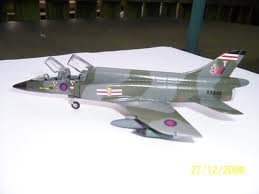Let's start with why Phantom happened. 1953, Korean War experience of tangling with the Sovs (System and proxies). $ were thrown at Dassault Mystere IV, (F.F. then to Super Mystere B.4), "Super" Swift, Hunter, and Javelin - schemed for nuclear strike, and the Century Series through F-108. Some failed early; some were deferred so their teams could make the simpler machines actually work. What emerged for many NATO Arms was F-100C, flying in 4ATAF to mid-1970s and humiliating Canberra B(I)6/8, and 2ATAF Javelins trying to find them.
After 4/57 UK decided that close support Venoms would be replaced by something cheap, expendable even, hence Gnat. Outcome was to re-role surplus Hunter F.6s just delivered, whose Task had been disappeared. That's why Hawker's wooden mock-up P.1121 found no favour, and it's why Camm failed (maybe never tried) to extract flight demo £ from his Board and from DH's (Gyron). Kingston/Dunsfold/Bitteswell were full, thank you, and remained so into mid-1970s retreading even GIA Hunter F.4.
DoD ran a competition to replace F-100C. Quite properly, favour was giving to re-role something proven. So: Q No.1 should be: what if USN had chosen not-McDonnell in 1954 (after all, Demon was no confidence-inspirer). Super Tiger, then? Land-based derivatives thereof were peddled by Grumman to FRG into late-1960s. Q No.2: what if F-110 Phantom had not won USAF, but A.N.Other Century, or Crusader, or Vigilante-variant.
Well, by 1964 UK would have taken that. Remember what we chose to define as the Task. Venoms were in practice not replaced - we had bought hundreds and ordered even more. We chose to do modest iron and move pronto to mushroom. But we became hugely confused and defined TSR.2 as able, after deleting Moscow, to take out a tank or two on way home. The Hunter FGA.9/FR.10/Sea Vixen FAW.2 replacement selected by Thorneycroft, 1963, was to disrupt fleet-sized incursion, land or sea, with a modestly Big Bang...and then to take out a tank or two...Just to say it shows the illogicality, thus basis for Healey to chop it all. There is no sortie both vertical and supersonic. Quite why we're contemplating doing it again with F-35B is baffling: the only reason that has not been chopped is myopia/vacillation in US Pols: Bush Jr. approaching his 2004 re-Election wondered aloud why US needed oodles of enhanced F-16, F-15 and A/F-18, plus F-22, plus F-35...but failed to do much about it.
So. A to OP Q: for mud-moving, never a Lightning. Readiness, impossibility of. Instead:
-if, late-1963, lumbered and trying to dodge inoperable, single-engine P.1154(RN), RN had no F-4 option, they would have championed an F-8K;
-if, early-1965, parrying new Ministers trying to chop a lot, RAF had no F-4 option, they would have taken whatever was being deployed in 4ATAF vice (F-110) F-4C. Whatever it was - maybe by Grumman, by Vought, by Republic. Because DoD offered highly attractive price/payment/offset terms. Not, as the myth has it, to boot out strong Brit competitors (who, what, where?), but for Force inter-operability.

